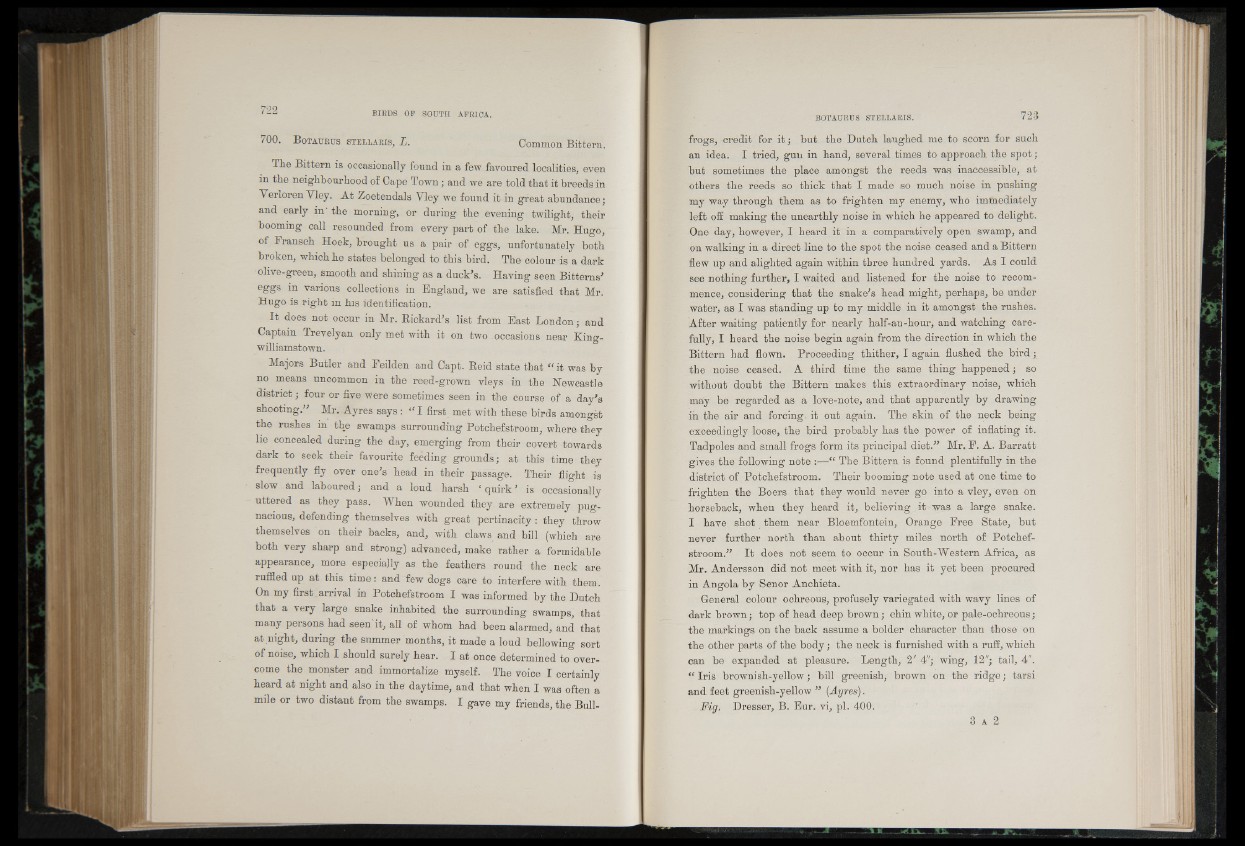
700. B otaurus steblaris, L. Common Bittern.
The Bittern is occasionally found in a few favoured localities, even
in the neighbourhood of Cape Town; and we are told that it breeds in
Yerloren Vley. At Zoetendals Yley we found it in great abundance;
and early in' the morning, or during the evening twilight, their
booming call resounded from every part of the lake. Mr. Hugo,
of Fransch Hoeb, brought us a pair of eggs, unfortunately both
broken, which he states belonged to this bird. The colour is a dark
olive-green, smooth and shining as a duck’s. Having seen Bitterns’
eggs in various collections in England, we are satisfied that Mr.
Hugo is right in his identification.
It does not occur in Mr. Rickard’s list from East London; and
Captain Trevelyan only met with it on two occasions near King-
williamstown.
Majors Butler and Eeilden and Capt. Reid state that " it was by
no means uncommon in the reed-grown vleys in the Newcastle
district; four or five were sometimes seen in the course of a day’s
shooting.” Mr. Ayres says : " I first met with these birds amongst
the rushes in the swamps surrounding Potchefstroom, where they
he concealed during the day, emerging from their covert towards
dark to seek their favourite feeding grounds; at this time they
frequently fly over one’s head in their passage. Their flight is
slow and laboured; and a loud harsh ‘ quirk’ is occasionally
uttered as they pass. When wounded they are extremely pugnacious,
defending themselves with great pertinacity : they throw
themselves on their backs, and, with claws and bill (which are
both very sharp and strong) advanced, make rather a formidable
appearance, more especially as the feathers round the neck are
ruffled up at this time: and few dogs care to interfere with them.
On my first.arrival in Potchefstroom I was informed by the Dutch
that a very large snake inhabited the surrounding swamps, that
many persons had seen it, all of whom had been alarmed, and that
at night, during the summer months, it made a loud bellowing sort
of noise, which I should surely hear. I at once determined to overcome
the monster and immortalize myself. The voice I certainly
heard at night and also in the daytime, and that when I was often a
mile or two distant from the swamps. I gave my friends, the Bullfrogs,
credit for it; but the Dutch laughed me to scorn for such
an idea. I tried, gun in hand, several times to approach the spot;
but sometimes the place amongst the reeds was inaccessible, at
others the reeds so thick that I made so much noise in pushing
my way through them as to frighten my enemy, who immediately
left off making the unearthly noise in which he appeared to delight.
One day, however, I heard it in a comparatively open swamp, and
on walking in a direct line to the spot the noise ceased and a Bittern
flew up and alighted again within three hundred yards. As I could
see nothing further, I waited and listened for the noise to recommence,
considering that the snake’s head might, perhaps, be under
water, as I was standing up to my middle in it amongst the rushes.
After waiting patiently for nearly half-an-hour, and watching carefully,
I heard the noise begin again from the direction in which the
Bittern had flown. Proceeding thither, I again flushed the b ird;
the noise ceased. A third time the same thing happened; so
without doubt the Bittern makes this extraordinary noise, which
may be regarded as a love-note, and that apparently by drawing
in the air and forcing, it out again. The skin of the neck being
exceedingly loose, the bird probably has the power of inflating it.
Tadpoles and small frogs form its principal diet.” Mr. E. A. Barratt
gives the following note :—“ The Bittern is found plentifully in the
district of Potchefstroom. Their booming note used at one time to
frighten the Boers that they would never go into a vley, even on
horseback, when they heard it, believing it was a large snake.
I have shot them near Bloemfontein, Orange Free State, but
never further north than about thirty miles north of Potchefstroom.”
It does not seem to occur in South-Western Africa, as
Mr. Andersson did not meet with it, nor has it yet been procured
in Angola by Senor Anchieta.
General colour ochreous, profusely variegated with wavy lines of
dark brown; top of head deep brown; chin white, or pale-ochreous;
the markings on the back assume a bolder character than those on
the other parts of the body; the neck is furnished with a ruff, which
can be expanded at pleasure. Length, 2' 4"; wing, 12"; tail, 4".
“ Iris brownish-yellow; bill greenish, brown on the ridge; tarsi
and feet greenish-yellow ” (Ayres).
Fig, Dresser, B. Eur. vi, pi. 400.